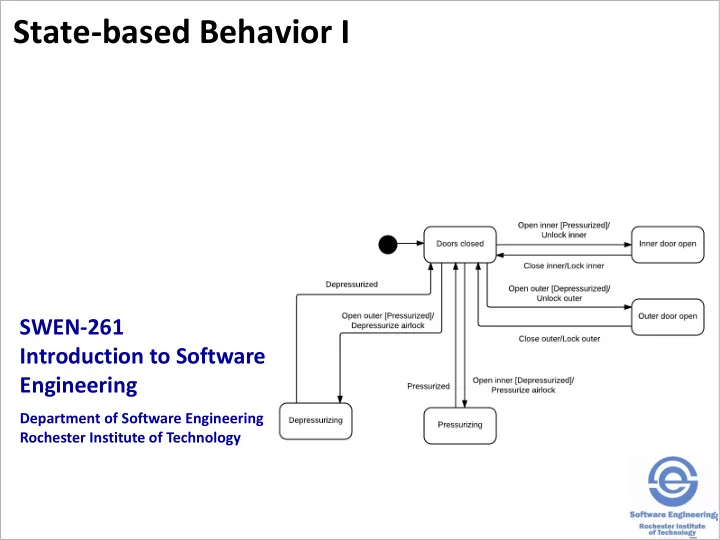

State-based Behavior I SWEN-261 Introduction to Software Engineering Department of Software Engineering Rochester Institute of Technology
A large part of software behavior is dependent on the state of the system, i.e. state-based. A finite-state machine is a notational mechanism for capturing this state-based behavior. • The UML diagram is called a statechart. Explicitly defining this state-based behavior provides a common specification for the team. Allowing the state behavior to evolve implicitly creates a situation where every team member may not have the same model of the behavior. 2
A statechart can define behavior in multiple areas in your application. Defining the operation of an interface, such as, the web application interface. • For an after class exercise, you will create a statechart that describes the sample webapp's web application interface. Specifying the behavior for a single object. • Later in the course, we will come back to statecharts and discuss how to implement the state-based behavior explicitly. 3
A statechart identifies the recognizable conditions that a system can be in over intervals of time. The system can exist in only one state at a time. • You typically want a deterministic state machine to define behavior of your software systems. The system exists in a state for a period of time. A solid ball specifies the starting point. 4
Transitions provide the mechanism for the system to move from one state to another. The event triggers the transition to be taken. • The event could be calling a method, receipt of a signal, end of a time period, or end of an activity. The guard is a Boolean condition that must be true for the transition to be triggered. When the transition is triggered, the action list is executed. 5
Transitions provide the mechanism for the system to move from one state to another. A transition executes instantaneously relative to the time spent in a state. A transition can return the system to the same state that it was in when the transition was taken. • Any actions would be executed before returning to the state just left. There can be any number of transitions entering or leaving a state. 6
Here is a statechart for control of an airlock. 7
Follow these guidelines when creating your statecharts. Pick meaningful state, event, and guard names. Always specify a starting point without a guard on the transition to the initial state. Guards on multiple transitions from a state with the same trigger event should be mutually exclusive. Evaluating the guard should have no side effects, and the guard cannot use side effects of actions on a transition it is guarding. 8
Use a statechart to get a shared understanding of the state-based behavior of a system. Even if you do not explicitly implement the states, you can more clearly capture the system behavior. There are frameworks that provide an implementation of state-based behavior, such as StatefulJ FSM (https://github.com/statefulj) or squirrel-foundation (https://github.com/hekailiang/squirrel) The full statechart notation has even richer semantics defined (entry/exit actions, composite states, orthogonal/concurrent states). 9
Recommend
More recommend